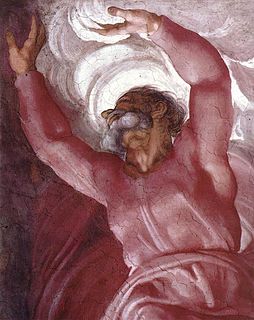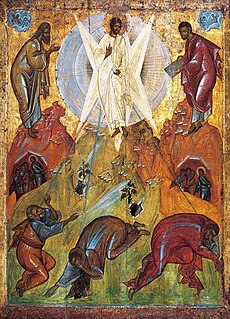 W
WAn-Nur is the 24th chapter (sūrah) of the Quran with 64 verses (āyāt).
 W
WGenesis 1:3 is the third verse of the first chapter in the Book of Genesis. In it God made light by declaration: God said, 'Let there be light,' and there was light. It is a part of the Torah portion known as Bereshit.
 W
WGenesis 1:4 is the fourth verse of the first chapter of the Book of Genesis. It is the response to God's command in verse 3, "Let there be light." It is part of the Genesis creation narrative within the Torah portion Bereshit. The verse states that the light was good, and that God divided or separated the light from the darkness. It has been interpreted in different ways, and illustrated by artists such as Michelangelo.
 W
WGenesis 1:5 is the fifth verse in the first chapter of the Book of Genesis, part of the Genesis creation narrative. In this verse, God names the newly created day and night. Interpretation of this passage hinges on the interpretation of Genesis 1:4. "Evening and morning" bring the narrative of the first day of Creation to a close, and there are also multiple interpretations of this phrase.
 W
WThe inward light, Light of God, Light of Christ, Christ within, That of God, Spirit of God within us, Light within, and inner light are related phrases commonly used within the Religious Society of Friends (Quakers) as metaphors for Christ's light shining on or in them. It was propagated by the founder of the Quaker movement, George Fox, who "preached faith in and reliance on 'inward light' ". The first Quakers were known to sit in silence and meditate on the words of the Bible until they felt the inward light of God shining upon them and the Holy Spirit speaking. Early Quakers taught: "God reveals Himself within each individual's conscience and consciousness by the Holy Spirit, Christ Himself being the Light to illumine man's sinfulness and lead in the way of truth and righteousness. ... this light is in all men by the grace of God to lead them to Christ, and that the same light will give daily guidance to the Christian."
 W
WJohn 1 is the first chapter in the Gospel of John in the New Testament of the Holy Bible. The author of the book containing this chapter is anonymous, but early Christian tradition uniformly affirmed that John composed this gospel.
 W
W"Let there be light" is an English translation of the Hebrew יְהִי אוֹר found in Genesis 1:3 of the Torah, the first part of the Hebrew Bible. In Old Testament translations of the phrase, translations include the Greek phrase γενηθήτω φῶς and the Latin phrases fiat lux and lux sit.
 W
WMatthew 5:14 is the fourteenth verse of the fifth chapter of the Gospel of Matthew in the New Testament. It is part of the Sermon on the Mount, and is one of a series of metaphors immediately following the Beatitudes.
 W
WMatthew 5:15 and Matthew 5:16 are the fifteenth and sixteenth verses of the fifth chapter of the Gospel of Matthew in the New Testament. They are part of the Sermon on the Mount, and is one of a series of metaphors often seen as adding to the Beatitudes. The previous verse compared the disciples to a City upon a Hill that can't be hidden. These verses present a similar analogy.
 W
WNūr may refer to the "Light of God". The word "nūr" is Arabic for "heatless light", and has been passed on to many other languages. It is often used in the Quran, notably in a verse that states has been the subject of much discussion. Many classical commentators on the Quran considered that this should be taken metaphorically, as in the sense that God illuminates the world with understanding, rather than literally. The first and foremost to representatively stand to the concept of Nur Muhammad being the quintessence of everything was Sayyid Abdul Qadir Gilani, who described this idea in his book Sirr ul Asrar. This concept was then preached by his disciples. One of Sayyid Abdul Qadir Gilani's disciples was the Andalusian scholar Abu Bakr ibn al-Arabi, who categorized nūr into different levels of understanding from the most profound to the most mundane. Shias believe nūr, in the sense of inner esoteric understanding, is inherited through the Imams, who in turn communicate it to the people.
 W
WSalt and light are images used by Jesus in the Sermon on the Mount, one of the main teachings of Jesus on morality and discipleship. These images in Matthew 5:13, 14, 15 and 16
 W
WIn Eastern Orthodox Christian theology, the Tabor Light is the light revealed on Mount Tabor at the Transfiguration of Jesus, identified with the light seen by Paul at his conversion.
 W
WLight of the World is a phrase Jesus used to describe himself and his disciples in the New Testament. The phrase is recorded in the Gospels of Matthew (5:14–16) and John (8:12). It is closely related to the parables of Salt and Light and Lamp under a bushel, which also appear in Jesus' Sermon on the Mount.